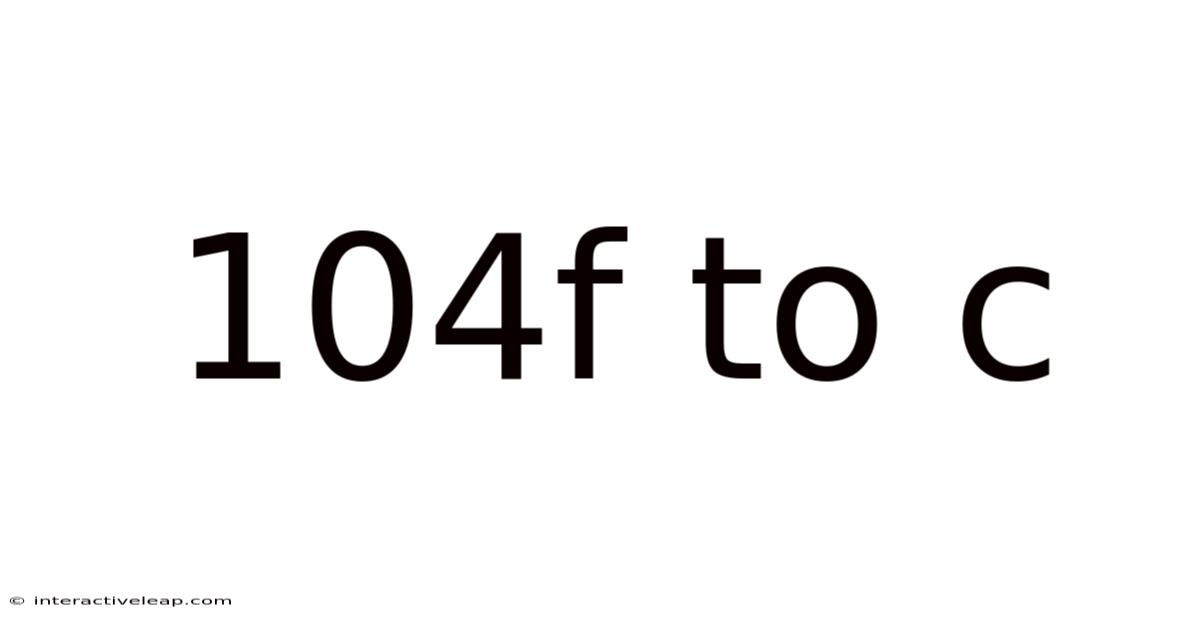104f To C
interactiveleap
Sep 17, 2025 · 4 min read

Table of Contents
Decoding 104°F to °C: A Comprehensive Guide to Temperature Conversion
Understanding temperature conversions is crucial in various fields, from cooking and everyday life to scientific research and industrial applications. One common conversion involves changing Fahrenheit (°F) to Celsius (°C), and this article will comprehensively guide you through converting 104°F to °C, explaining the process, the underlying science, and providing valuable context. We'll delve into the formulas, explore practical applications, and address frequently asked questions. Learn to confidently navigate temperature conversions and unlock a deeper understanding of this fundamental scientific concept.
Understanding the Fahrenheit and Celsius Scales
Before diving into the conversion of 104°F to °C, let's establish a clear understanding of both scales. The Fahrenheit scale, developed by Daniel Gabriel Fahrenheit in the early 18th century, is primarily used in the United States. It defines the freezing point of water as 32°F and the boiling point as 212°F, with a difference of 180 degrees between them.
The Celsius scale, also known as the centigrade scale, is the more widely used system internationally and is based on the metric system. It defines the freezing point of water as 0°C and the boiling point as 100°C, with a 100-degree difference. This consistent 100-degree range between these key points simplifies many scientific calculations and makes it more intuitive.
Converting 104°F to °C: The Formula and Calculation
The conversion from Fahrenheit to Celsius follows a simple yet essential formula:
°C = (°F - 32) × 5/9
Let's apply this formula to convert 104°F:
°C = (104 - 32) × 5/9
°C = 72 × 5/9
°C = 40
Therefore, 104°F is equal to 40°C.
Practical Applications of 104°F (40°C)
A temperature of 104°F (40°C) holds significance in various contexts:
-
Human Body Temperature: A temperature of 104°F (40°C) signifies a high fever in humans. This warrants immediate medical attention, as it indicates a serious infection or other underlying health issue. Prompt medical intervention is crucial to prevent complications.
-
Cooking and Food Safety: In culinary applications, 40°C is a crucial temperature to prevent bacterial growth. Food should ideally be refrigerated below this temperature to maintain safety and prevent spoilage. Understanding this temperature threshold is essential for proper food handling and storage.
-
Industrial Processes: Many industrial processes, particularly those involving chemical reactions or material processing, require precise temperature control. 40°C is often a relevant temperature in various applications, necessitating accurate monitoring and regulation to ensure optimal results.
-
Environmental Studies: In environmental science and meteorology, 40°C can indicate extreme heat conditions. Understanding these temperatures is crucial for assessing heat waves, predicting their impact, and implementing preventative measures.
The Science Behind Temperature Scales and Conversions
The conversion formula itself is derived from the relationship between the Fahrenheit and Celsius scales' defining points. The formula accounts for the different freezing and boiling points and the varying degree intervals between them.
-
Difference in Freezing Points: The Fahrenheit scale starts at 32°F for the freezing point of water, whereas the Celsius scale starts at 0°C. This difference of 32 degrees is accounted for by subtracting 32 from the Fahrenheit temperature before further conversion.
-
Difference in Degree Intervals: There are 180 degrees Fahrenheit between the freezing and boiling points of water (212°F - 32°F = 180°F), and 100 degrees Celsius between the same points. The ratio of 5/9 (or 100/180 simplified) converts the Fahrenheit interval to the Celsius interval.
Frequently Asked Questions (FAQ)
Q: Why are there different temperature scales?
A: Different temperature scales arose historically due to different approaches to defining temperature measurements. The Fahrenheit scale was developed earlier and based on different reference points. The Celsius scale, aligned with the metric system, has become more widely adopted for its simplicity and international consistency.
Q: Is it possible to convert from Celsius to Fahrenheit?
A: Yes, the reverse conversion is equally possible using the following formula:
°F = (°C × 9/5) + 32
Q: What other temperature scales exist?
A: Besides Fahrenheit and Celsius, other temperature scales exist, such as the Kelvin scale, which is an absolute temperature scale used extensively in science.
Q: Are there online calculators for temperature conversion?
A: Yes, numerous online calculators are readily available to perform quick conversions between Fahrenheit and Celsius (and other scales).
Beyond the Conversion: Understanding Temperature's Importance
Beyond the simple mathematical conversion of 104°F to 40°C, understanding temperature's broader significance is crucial. Temperature is a fundamental physical property that impacts numerous aspects of our lives and the world around us. It dictates the state of matter, influences chemical reactions, drives weather patterns, and is a critical factor in maintaining human health and ensuring food safety.
Conclusion: Mastering Temperature Conversions
Mastering the conversion from Fahrenheit to Celsius, as demonstrated by converting 104°F to 40°C, is a valuable skill with wide-ranging applications. Understanding the underlying science, the formula, and the practical implications empowers you to navigate diverse situations, from everyday life to professional contexts. Remember, this knowledge is not merely about calculations; it's about understanding a fundamental physical property that shapes our world. Armed with this knowledge, you can confidently handle temperature conversions and appreciate their importance in various aspects of life.
Latest Posts
Latest Posts
-
179 X 2
Sep 17, 2025
-
80 Of 140
Sep 17, 2025
-
13th Square Number
Sep 17, 2025
-
66 0kg In Stone
Sep 17, 2025
-
6th Century Bce
Sep 17, 2025
Related Post
Thank you for visiting our website which covers about 104f To C . We hope the information provided has been useful to you. Feel free to contact us if you have any questions or need further assistance. See you next time and don't miss to bookmark.